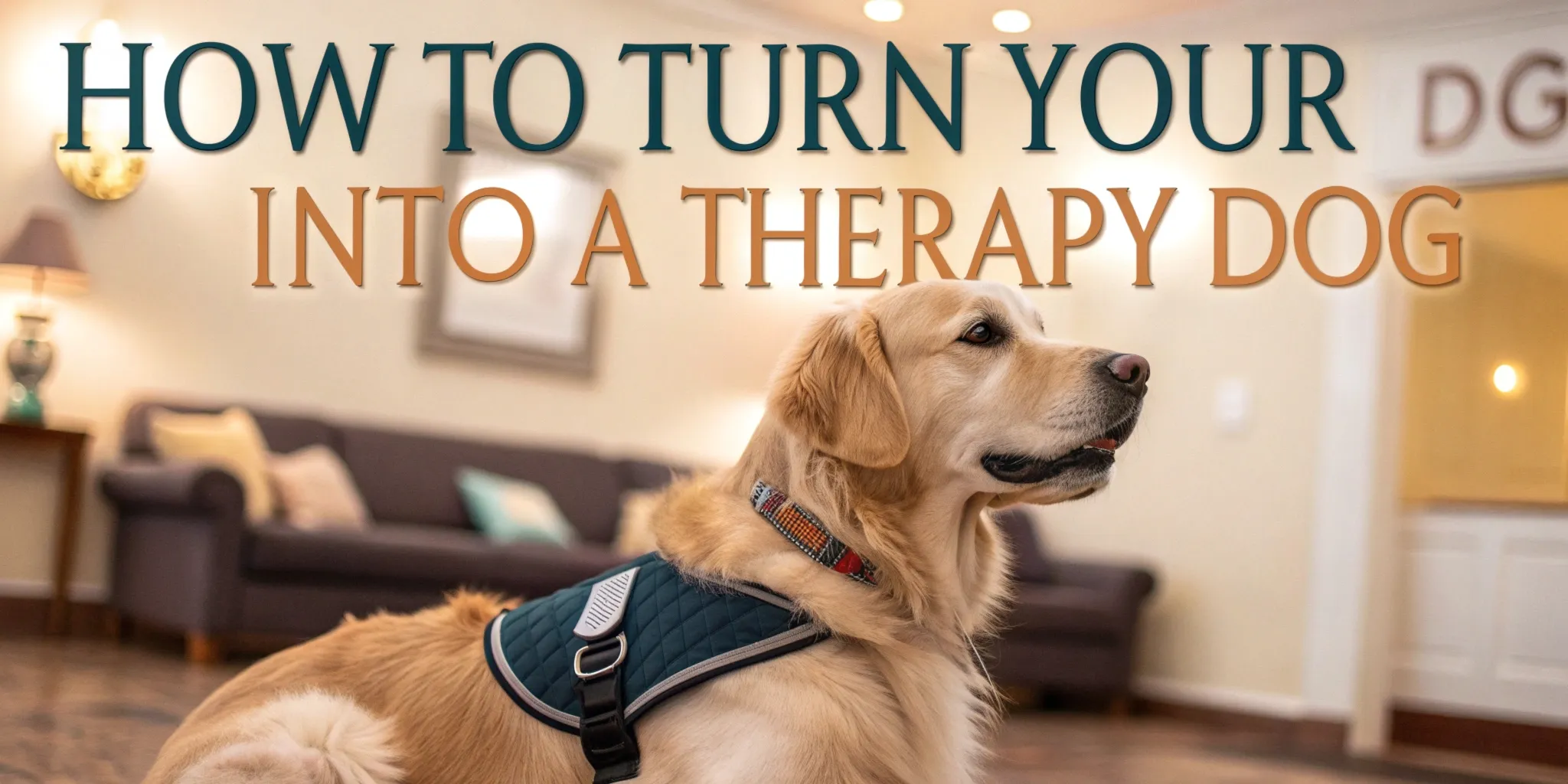Therapy dogs are of immense importance to enhance the welfare of individuals in hospitals, nursing homes, schools, and other therapeutic settings. They give emotional support, comfort, and companionship to the needy. If you want to turn your dog into a therapy dog, then you’re taking on a rewarding journey that will benefit others while strengthening your bond with your canine companion.
Positive Reward training is a great way to make the process smoother, helping your dog build the skills and behavior needed for therapy work while keeping the experience positive and enjoyable.
At K9 University, we offer therapy dog training in OKC, including the essential Canine Good Citizen (CGC®) Program. This program teaches responsible pet ownership and good manners, covering 10 key skills. Successfully completing the CGC test helps prepare your dog for therapy work while strengthening the bond between you and your canine companion.
What is a Therapy Dog?
A therapy dog is a trained dog that provides comfort and support to individuals in various settings, such as hospitals, nursing homes, schools, or rehabilitation centers. These dogs are not service dogs, but they help reduce stress and anxiety and provide emotional support through their companionship. Therapy dogs undergo specialized training to interact calmly with people and be sensitive to their needs, offering therapeutic benefits like promoting relaxation and emotional healing.
How Can You Train Your Dog to Become a Therapy Dog?
Training a therapy dog requires more than just basic obedience. It involves helping your dog develop the skills and temperament needed to provide comfort and support in various settings. From mastering socialization to acquiring therapy-specific abilities, each step is designed to prepare your dog for this meaningful role. Below, we outline the key steps to guide you through the process of turning your dog into a certified therapy dog.
Step 1: Evaluate Your Dog’s Temperament
Not every dog is suited for therapy work. Before starting the training process, it’s important to evaluate your dog’s temperament to see if they are a good fit for therapy work.
Signs Your Dog May Be a Good Candidate:
- Calm and Friendly: Therapy dogs need to remain calm in various environments and around different types of people.
- Social and Non-Aggressive: They should be comfortable with strangers, including children and the elderly.
- Gentle and Patient: Therapy dogs must be patient and non-reactive, especially in a busy or stressful environment.
- If your dog shows natural people affection and stays calm in different situations, it may have the potential to become a therapy dog.
Step 2: Basic Obedience Training
The basic obedience skills that your dog must master before applying for therapy dog certification include commands like sit, stay, come, heel, and leave it without hesitation. These fundamental training skills ensure that your dog is well-mannered and controllable in order to be useful in therapy work.
Important Commands of Therapy Dogs
- Sit and Stay: The dog must remain in place and be calm.
- Come: Allows you to summon a dog to you regardless of conditions
- Leave it: Teaches a dog how not to be distracted, highly in situations with new smells, sights
- Heel: Ensure the dog walks by side on a leash without tugging
At K9 University, we offer private dog training lessons along with group obedience training for dogs to help accomplish these basic obedience skills. These lessons set the foundation for how successful your therapy dog education will be, ensuring that your dog is well-prepared for therapy work.
Step 3: Socialization with People and Other Animals
Therapy dogs are exposed to many different kinds of people such as children, elderly persons, and people with various disabilities. They may also be exposed to other animals in public places. Early socialization of your dog or continuing socialization in adult dogs is important to their comfort and success in therapy.
Tips for Successful Socialization:
- Introduce Your Dog to Different People: Encourage positive interactions with various people, including people with disability, children, and older adults.
- Expose Your Dog to Different Environments: Take your dog to bustling places such as parks, stores, or crowded events to help your dog to become accustomed to different environments and sounds.
- Create Positive Experiences: All experiences have to be positive and enforce calm behavior through treats and praise.
Socialization is the most important thing for therapy dogs, and at K9 University, we train them on all aspects with a comprehensive approach that involves socialization with people as well as other animals, so your dog is prepared for any environment for therapy work.
Step 4: Training for Specific Therapy Dog Skills
Once your dog has learned basic obedience and socialization, it is time to focus on specific therapy dog skills. Therapy dogs need to be calm, patient, and gentle with the people they meet. They must also be able to handle different situations without becoming anxious or aggressive.
Important Skills for Therapy Dogs
- Gentle Touch: Teach your dog to accept petting, brushing, and other forms of gentle touch from strangers.
- Desensitization to Medical Equipment: While in hospitals, your dog will likely see wheelchairs, walkers, and other medical equipment. Your dog will learn to keep calm about such items from desensitization.
- Remaining Calm in Trying Times: Therapy dogs are exposed to many stressful situations involving people who are stressed or in pain. Your dog should be able to maintain his composure in those situations.
At K9 University, we offer behavior correction and training that will help your dog develop these specific skills. Our trainers use positive reinforcement techniques to ensure your dog remains calm and composed in all therapy settings.
Step 5: Therapy Dog Certification
For a dog to be recognized as a licensed therapy dog, a therapy dog organization evaluation needs to be completed. This usually includes an evaluation process for the dog through either Human Animal Link of Oklahoma (HALO), Pet Partners, or the Alliance of Therapy Dogsto analyze his temperament, behavior, and obedience skills. Upon approval in the evaluation, they can officially become certified therapy dogs.
Requirements to become Certified
- The age should be one year or above.
- Your dog must have a laid-back and docile temper.
- Your dog must make it through a series of obedience tests and behavior studies.
Your dog must demonstrate the ability to work both indoors and outdoors and for a variety of people, including children, the blind, and others.
Privately at K9 University we can assist you in fine-tuning your dog on the skills that will serve him well for the final evaluation.
Step 6: Ongoing Training and Maintenance
Even after certification, therapy dogs continue to need training to continue their skills. Reinforcing obedience, socialization, and therapy-specific skills must be continued so that your dog remains effective in the role.
Ongoing Training Tips:
- Keep socializing with new people and new settings.
- Use obedience commands regularly.
- If you can, expose your dog to different therapy environments.
K9 University provides therapy dog ongoing training and behavior correction services. We want to help you and your dog on their therapy journey each step of the way.
Your Dog is Making a Difference
Training your dog to be a therapy dog is one of the more fulfilling experiences you can have that can benefit other people’s lives as well. We at K9 University are here to help you and your dog succeed in this space. We offer the experience and therapy dog training needed to prepare your dog to be an amazing therapy companion.
If you are ready to start your pooch’s journey of training to help others, get in touch with K9 University today! With guidance from our expert trainers, you will take your dog step-by-step in making this rewarding change in lives of people in need.



